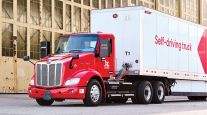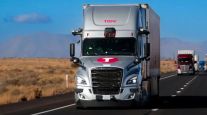Managing Editor, Features and Multimedia
Assembling the Autonomous Truck
[Stay on top of transportation news: Get TTNews in your inbox.]
Truck makers and tech startups continue to make progress in their pursuit of autonomous trucks, but moving this elusive technology past the testing and development phase to broad commercialization will require a great deal of integration work.
Manufacturers, suppliers and automated vehicle developers will need to piece together a complex combination of software, sensors and new components to safely introduce fully self-driving trucks on the nation’s highways.
Most of the attention naturally goes to the automated driving software that enables autonomous operation, as well as the onboard sensors — such as lidar, radar and cameras — that monitor the vehicle’s surroundings.

Clevenger
But self-driving trucks also will require a new set of safety components to enable SAE Level 4 automated driving, where the vehicle can drive itself with no human input or intervention — at least under certain conditions.
Without the safety blanket of a driver behind the wheel to serve as a fallback, Level 4 trucks will require redundant braking, steering and powertrain control systems to ensure safety in the event of a component failure, developers say.
That will be one of the key challenges that truck manufacturers and automated driving companies will need to address through joint development efforts.
One prominent example is the recently announced partnership between Daimler Trucks and autonomous driving developer Waymo. The companies have set out to produce Class 8 Freightliner models piloted by the Waymo Driver.
Waymo, which began as the Google Self-Driving Car Project in 2009, has introduced a fully autonomous ride-hailing service in Phoenix using modified Chrysler Pacifica minivans outfitted with backup braking, steering and power systems.

More Q4 iTECH stories
- The Rising Threat of Ransomware: How Trucking Can Fend Off Cyberattacks
- E-Smart Targets Better Tractor-Trailer Connectivity
- The Rise of the Warehouse Robot
- Trailer-Sharing Startup vHub Expands Marketplace
- Plus, FAW Self-Driving Truck Passes Certification Test in China
- Clevenger: Assembling the Autonomous Truck
- Spearin: Can On-Demand Freight Really Work for Trucking?
- Dysart: Curing Remote Workers’ Blues
The same type of modifications will need to happen with self-driving Class 8 trucks, Waymo CEO John Krafcik said on a call announcing the agreement with Daimler.
That means truck makers and Tier 1 suppliers first will need to develop and mass produce those redundant components, and that won’t happen overnight.
The task of developing and deploying Level 4 trucks also will require a major leap forward from the Level 2 driver-assist capabilities entering the market today. The latest advanced driver assist systems, which now incorporate automated braking, acceleration and steering functions, still require the driver to remain actively engaged at all times.
Krafcik said highly automated Level 4 systems will not simply evolve from today’s driver-assist systems.
“There is really no path from L2 to L4,” he said. “There’s a huge chasm. It’s a completely different development mindset.”
Safety, of course, will be paramount to any successful rollout of self-driving trucks.
“We will not release a vehicle for Level 4 operation until we are absolutely convinced that it is safe to operate,” said Roger Nielsen, CEO of Daimler Trucks North America.
In addition to its partnership with Waymo, DTNA also is testing and developing Level 4 trucks in conjunction with its Torc Robotics subsidiary.
Other technology developers and truck makers also have been teaming up to tackle the autonomous truck challenge by integrating automated-driving systems with commercial vehicles. TuSimple, for one, has partnered with Navistar and Traton Group to develop self-driving trucks in North America and Europe. At the same time, Volvo Trucks and Paccar Inc., the parent of Kenworth and Peterbilt, also have been investing in various forms of automated driving capabilities.
In any discussion of autonomous trucks, it’s important to remember that this technology will not remove the need for professional drivers. If developers succeed in bringing Level 4 trucks to market, these vehicles will be designed for specific applications that are well suited to automation.
There’s no doubt that drivers will remain absolutely essential to the trucking industry for as long as we can realistically envision.
In the future, though, truck drivers may someday share the road and swap trailers with autonomous trucks.
For that vision to become a reality, manufacturers, suppliers and tech developers all will play an important role in pushing Level 4 trucks beyond testing and development to commercialization and factory production.
Want more news? Listen to today's daily briefing:
Subscribe: Apple Podcasts | Spotify | Amazon Alexa | Google Assistant | More




